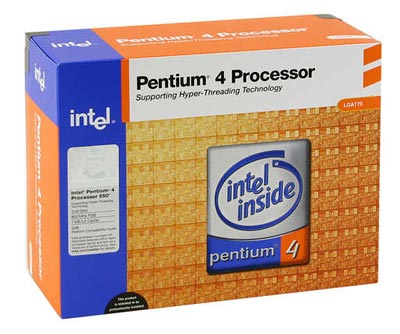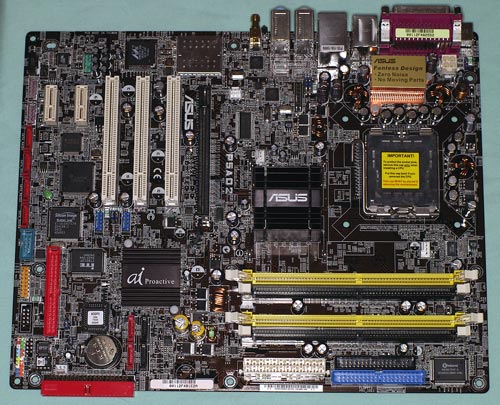High End Buyer's Guide - September 2004
by Wesley Fink on August 30, 2004 12:22 AM EST- Posted in
- Guides
CPU and Motherboard Alternatives
CPU: Intel Pentium 4 560 (3.6Ghz)Motherboard: Asus P5AD2 Premium (Intel 925X)
Price: CPU - $505 shipped (Retail with HSF). Motherboard - $264 shipped
It was difficult to decide between the Single-Channel Socket 754 Athlon 64 and the new Intel Socket 775 for the High-End alternative. Despite the massive increase in memory bandwidth that comes with the Dual-Channel 939, the fact remains that the Athlon 64 is not particularly bandwidth-starved compared to recent deep-pipe Intel designs. As you can see in the launch article on Socket 939, this translates into performance of the single-channel 754 Athlon 64 that is only 2% to 9% slower than the new 939 at the same speed. In real terms, this means that a Socket 754 combined with a second-generation Socket 754 motherboard with AGP/PCI locks is still slightly outperforming Intel's latest and greatest Pentium 4 560 (3.6GHz). The new pricing of the 2.4GHz 3700+ at about $525 also makes this tempting for the High-End Value shopper. The 754 is still a very good alternative, but in the end, the new Socket 775 on one of the motherboards that solves the Intel OC lock riddle won out as the High-End alternative due to the combination of features and future.

Intel produces processors with locked multipliers, so for raw performance, we chose the highest Intel stock speed. The Intel 560, running at 3.6GHz and based on the 90nm Prescott core, is the fastest Intel CPU you can buy today. As Anand found in the Socket 775 launch review CPU benchmarks, the 560 is generally faster than the more expensive 3.4EE, which has double the cache, but is based on the 130nm Northwood core. Most Socket 775 processors that we have tested tend to top out in the 3.8GHz to 4.0GHz range with modest voltage increases, so overclockers choosing a 775 CPU may want to choose a slower 775, like the 3.2GHz to balance ultimate overclock with board Clock frequency capabilities.
In this case, the Asus P5AD2 tops out at 278 with ATI PCIe video or about 260 with nVidia PCIe. We also showed, in our DDR2 memory roundup, that all current DDR2 memory could run at DDR2 667, which is achieved at a Clock frequency of 250. This means that if you are an experienced overclocker, you can achieve the same or higher performance with a 3.2E Socket 775 matched to the Asus P5AD2.
However, this is the High-End Buyer's Guide and there is no doubt that overall, the 560 is the fastest stock Intel Socket T processor that you can buy. This makes the 560 the ideal choice for a Socket T, PCI Express, DDR2 High-End system.

The Intel 925X chipset is Intel's Enthusiast chipset, and we recently compared 925X motherboards in our 925X Roundup. The Gold Editor's Choice in that roundup was the Asus P5AD2, which makes the Asus the logical choice for our High-End Intel system.
The P5AD2 Premium is clearly top-of-the-line in every way. All of the Asus Proactive AI (Artificial Intelligence) features are included, and Asus proudly advertises the overclocking features of the P5AD2 Premium. This includes a special cooling plate on the bottom of the board in the CPU area that Asus calls Stack Cool.
Asus includes Dual Gigabit PCI Express LAN on the P5AD2, with both LAN ports powered by the new Marvel 88E8053 Ethernet controllers. You will also find a complete WiFi set-up with an 802.11g card and antenna included for the WiFi slot. Asus uses the premium C-Media CMI9880 codec supporting the Intel High-Definition audio, with 8 channels and Dolby Digital Live technology support. The P5AD2 also adds the DDR2 memory option of 600MHz at stock speed in addition to the common 533 and 400 options.
The storage area is one area where the Asus stands out compared to other 925X boards. All 925X support the ICH6R standard 4 SATA/1 IDE (2drives) configuration. The Asus adds 4 more SATA ports for a total of 8 SATA ports, and also adds an ITE controller for 2 more IDE devices for a total of 4.
When Socket 775 was launched, it did not appear that any of the new 925X/915 motherboards would ever become a recommended performance motherboard. Performance was fine if you looked only at stock speeds, but the 925x/915 boards appeared limited to about a 10% overclock by design. This severely limited performance at the very top compared to Intel 875/865 chipset boards. However, the P5AD2 has turned out to be the best overclocker that we have seen so far among the 925X motherboards. In our tests, the Asus reached 278 FSB with the difficult combination of a top-end ATI X800 XT PCIe video card and a SATA hard drive. This puts the P5AD2 in the same performance ballpark as the best 875 boards, making it easier to choose a 925X system as the high end alternative system.
The P5AD2 is an expensive motherboard, but it will take 775 performance to places that are difficult to reach with other 925X motherboards. It was designed from the start to be a dream board for Performance computing, and Asus even provides a full range of AI overclock options for the more timid, with auto presets from 5% to 30% overclock, which represent a range of auto overclocks to FSB1066/DDR2-710.
There is also a full range of both familiar and new manual settings for overclockers who like to dial their own.
Listed below is part of our RealTime pricing engine, which lists the lowest prices available on the Intel CPUs and motherboards from many different reputable vendors:
If you cannot find the lowest prices on the products that we've recommended on this page, it's because we don't list some of them in our RealTime pricing engine. Until we do, we suggest that you do an independent search online at the various vendors' web sites. Just pick and choose where you want to buy your products by looking for a vendor located under the "Vendor" heading.










53 Comments
View All Comments
Wesley Fink - Wednesday, September 1, 2004 - link
Uff -The two FX53 I've tested both run fine at 2.6GHz (future FX55 spec) with stock cooling. While you will get more potential with better cooling, you are not locked out of using a higher multiplier just because you use stock cooling. The AMD Retail HSF does a decent job of cooling, though there are certainly better solutions available.
Uff - Wednesday, September 1, 2004 - link
My point with FX-53 and stock cooling was exactly that: the main bonus you get with FX-53 is that it's multiplier unlocked but to make any use of that you need proper cooling.Wesley Fink - Wednesday, September 1, 2004 - link
#40 - The DVD prices were pulled at slightly different times for the Recommended and Alternate systems. For consistency, both charts now show a $97 price for the Pioneer 108. Prices constantly change, so any published price will generally be off in a few days or weeks.Goi - Tuesday, August 31, 2004 - link
Why is it that the DVD burner in the recommended high-end system costs $97 yet the exact same one in the alternate high-end system costs $96?krawl3r - Tuesday, August 31, 2004 - link
every single time, these guides ignore 2 of the best PSUs on the market: the PC Power and Cooling 510Deluxe which is miles ahead of the antec. Also ignored is the Fortron 530s. In my experience, the Fortrons are at least on par with the Antecs of not equal.P.S. If you spend the money on an FX-53 you might as well get a server board and go with the 940pin version so you can plug in a SCSI RAID card and have an array of 73GB 15k drives....just my $0.02
neogodless - Tuesday, August 31, 2004 - link
There is no "be all, end all" guide to anything, particularly in a rapidly changing technology environment. This guide is merely a guide. A place to start from, and go from there. They recommend getting the keyboard and mouse that is right for you, whether it be $70 or $10. However, I think there may be some logic in requesting that there's more of a reasonable scale from budget, mainstream, and high-end. This high-end guide tries to balance having enough money to buy the fastest computer with trying to make it affordable to a relatively wide audience, but really, I think there may be a different way to go about it. I think you could save a lot of money for a minimally slower computer, and by doing that, saving money for your next high-end machine. If you get the absolutely fastest machine, then there really should be no limits on money, and it should really be a no budget dream machine. If you're on a budget, even if it's $5000, you might want to be a little tiny bit stingier, and make sure that six months or a year from now, you still have a good budget for getting a high end rig.The only typo I saw was "could care less" in the audio section. Should be "couldn't care less".
The guides are a lot of work, and I think they are somewhat reasonable starting points. I appreciate them, even though I don't really use them for my own purchasing decisions. They are interesting, and hopefully helpful to some people.
jbritt1234 - Tuesday, August 31, 2004 - link
How can you build a $3500 PC and then suggest a $10 mouse??? That's crazy! Lost a little respect for ya there.Wesley Fink - Tuesday, August 31, 2004 - link
Uff - The improvements from Dual-Channel and 1024k cache vs. 512k cache are cumulative. So while either improvement alone is only 2 to 4% improvement, together the added cache and dual channel make the FX53 5% to 8% faster than the SC 512k 3700+ you suggest. If you want the top performance then the FX53 is the fastest.The FX53 is also completely unlocked, up and down, unlike the 3700+, 3800+, 3500+, or 3400+, which makes it possible to run at 2.6GHz for example at DDR400. All Athlon 64 are unlocked down, but only the FX is completely unlocked.
Uff - Tuesday, August 31, 2004 - link
I'm just wondering why anyone in their right mind would buy an FX-53 and run it on stock cooling? Other than making more space in your room by taking out some of the spare piles of money, there is no real gain in it compared to say 3700+ (or even a 2.4GHz 3400+, since tests have shown little gain from the extra 512kb cache).Caligynemania - Tuesday, August 31, 2004 - link
I am surprised that you reccomend mere computer speakers for a high end system. A receiver/speaker system (albeit more expensive) would be more appropriate for a high end system. I realize that this is outside the scope of a computer buyer's guide, but I think anyone who truly appreciates music/sound/noise would be willing to spend the $500 for a set of speakers that will last a lifetime (speakers dont go obselete or break). Combined with a good receiver (additional $100) you can output amazing sound from the radio, tv, computer, dvd. For $500 you can get the amazing NHT SB3 speaker system or the Klipsch RB25's.